Energy-Effective Cooperative and Reliable Delivery Routing Protocols for Underwater Wireless Sensor Networks
Abstract
1. Introduction
2. Contributions
- To minimize the network energy consumption, EERD scheme is designed for U-WSNs, in which the choice of nodes for information forwarding is achieved using certain weight function parameters (highest residual energy, lowest BER, and shortest distance). The scheme chooses a node among the neighbor nodes as a DSN, which has the highest function value. The selection parameter of highest residual energy helps to choose the robust node as a DSN, which prolongs the network lifetime. The shortest distance decreases the path length, which also decreases energy consumption. The scheme reduces the adverse channel impairments, by checking the BER and selecting the best link for further packet forwarding. Due to single-path routing and robust function attribution in the scheme, it decreases the energy consumption, maximizes the network life, and minimizes delay.
- Single-path routing in EERD decreases the network reliability. To improve the reliability, the CoEERD scheme is introduced, which uses the cooperation of a single RLN with the DSN. The best forwarder nodes (RLN and DSN) are selected by considering the above discussed function parameters. The SRN advances the information packet towards the RLN and DSN using broadcast nature. The DSN checks the BER, if it is above the threshold, it forwards a request (REQ) to the RLN for sending the same packet. The RLN retransmits the packet along with the ACK to DSN. For diversity, the MRC technique is used, which merges packets and advances them further to the final DSN.
- For quick packet delivery, the shortest Euclidian distance is used as a selection parameter for the best forwarder nodes. The calculation of the shortest distance between the source, DSN, and RLN reduces the path length. The latency during the packet advancement decreases and the ratio of packet delivery increases in both the schemes.
- Energy consumption is low in the EERD scheme. The inclusion of cooperation to EERD to make the CoEERD scheme uses one more node as a relay node. This increases energy usage of CoEERD. However, it has still lower energy consumption than some other existing schemes involving cooperation.
3. Literature Review
4. Designed Schemes
4.1. Effective Energy and Reliable Delivery (EERD) Routing
Network Initialization
4.2. Neighbors Recognition
4.3. Destination Nodes Selection and Information Proceeding
4.4. Cooperative Effective Energy and Reliable Deliver (CoEERD) Routing
Relay and Destination Node Selection
4.5. Data Forwarding and Cooperation
| Algorithm 1: Information sharing, path set up and data forwarding in EERD and CoEERD. |
| Start Network initialization BER: Bit Error Rate SN: Source node T: Transmission range DN: Destination node RN: Relay node R.E: Residual energy BER: Bit error rate SKN: Sink node d: Distance Control packet broadcast Find optimal relay Calculate function Function(f)= R.E/ BER ×d if Node have maximum function value=then DN selected=do if BER > 0.5 Find RN=do RN found=true if BER < 0.5 Packet accepted=true check SKN vicinity if Sink exists the T of the SN=then Packet reached to the SKN=true while Use multi-hoping Packet reached to the SKN=do Packet accepted= true end if end if end if end if end while break |
5. Simulation Setting and Results
5.1. Total Network Consumed Energy
5.2. RODP or Packet Delivery Ratio (PDR)
5.3. Total Delay of the Network
5.4. Total Successfully Received Packets
5.5. Total Alive Nodes of the Network
6. Conclusion and Future Directions
Author Contributions
Funding
Conflicts of Interest
Abbreviations
| U-WSNs | Underwater wireless sensor networks |
| EERD | Effective energy and reliable deliver routing |
| CoEERD | Cooperative effective energy and reliable deliver routing |
| ODBR | Optimized depth base routing |
| CoDBR | Cooperative depth base routing |
| RSSI | Received signal strength indicator |
| CSI | Channel state information |
| PSD | Power spectral density |
| RODP | Ratio-of-delivered packet |
| SNR | Signal to noise ratio |
| MRC | Maximal ratio combine |
| AF | Amplifying and forward |
| Transmission range | |
| BER | Bit error rate |
| RER | Residual energy ratio |
| FLT | Fuzzy logic technique |
| ACK | Acknowledgment |
| ID | Identification |
| DSN | Destination node |
| CR | Cooperative routing |
| CP | Control packet |
| RLN | Relay node |
| RLNs | Relay nodes |
| SRN | Source node |
| NACK | Negative acknowledgment |
| RF | Radio frequency |
| DF | Decode and forward |
| REQ | Request send |
| E-2-E | End-to-end |
References
- Akyildiz, I.F.; Pompili, D.; Melodia, T. Underwater acoustic sensor networks: research challenges. Ad hoc Netw. 2005, 3, 257–279. [Google Scholar] [CrossRef]
- Jiang, Z. Underwater acoustic networks—Issues and solutions. Int. J. Intell. Control Syst. 2008, 13, 152–161. [Google Scholar]
- Wahid, A.; Lee, S.; Kim, D. A reliable and energy efficient routing protocol for underwater wireless sensor networks. Int. J. Commun. Syst. 2014, 27, 2048–2062. [Google Scholar] [CrossRef]
- Erol, M.; Vieira, L.F.; Gerla, M. Localization with Dive’N’Rise (DNR) beacons for underwater acoustic sensor networks. In Proceedings of the Second Workshop on Underwater Networks, Montreal, QC, Canada, 14 September 2007; pp. 97–100. [Google Scholar]
- Sozer, E.M.; Stojanovic, M.; Proakis, J.G. Underwater acoustic networks. IEEE J. Ocean. Eng. 2000, 25, 72–83. [Google Scholar] [CrossRef]
- Al-Dharrab, S.; Uysal, M.; Duman, T. Cooperative underwater acoustic communications [accepted from open call]. IEEE Commun. Mag. 2013, 51, 146–153. [Google Scholar] [CrossRef]
- Maqsood, H.; Javaid, N.; Zain-ul-Abidin, M.; Ejaz, M.; Shakeel, U. Energy balanced interference aware energy efficient depth base routing protocol for UWSNs. In Proceedings of the 2015 10th International Conference on Broadband and Wireless Computing, Communication and Applications (BWCCA), Krakow, Poland, 4–6 November 2015; pp. 13–19. [Google Scholar]
- Wahid, A.; Kim, D. An energy efficient localization-free routing protocol for underwater wireless sensor networks. Int. J. Distrib. Sens. Netw. 2012, 8, 307246. [Google Scholar] [CrossRef]
- Shah, M.; Javaid, N.; Imran, M.; Guizani, M.; Khan, Z.A.; Qasim, U. Interference aware inverse EEDBR protocol for underwater WSNs. In Proceedings of the 19th International Conference on Complex, Intelligent, and Software Intensive Systems (CISIS), Fukuoka, Japan, 6–8 July 2016; pp. 256–263. [Google Scholar]
- Khan, A.; Ejaz, M.; Javaid, N.; Azeemi, M.Q.; Qasim, U.; Khan, Z.A. EEORS: Energy Efficient Optimal Relay Selection Protocol for Underwater WSNs. In Proceedings of the 19th International Conference on Network-based Information System, Ostrava, Czech Republic, 7–9 September 2016; pp. 239–245. [Google Scholar]
- Khan, A.; Javaid, N.; Mahmood, H.; Sangeen; Khan, Z.A.; Qasim, U. EEORS: Energy Efficient Optimal Relay Selection Protocol for Underwater WSNs. In Proceedings of the 10th International Conference on Complex, INtelligent, and Software Intensive System, Fukuoka, Japan, 6–8 July 2016; pp. 264–270. [Google Scholar]
- Shah, S.; Khan, A.; Ali, I.; Ko, K.M.; Mahmood, H. Localization Free Energy Efficient and Cooperative Routing Protocols for Underwater Wireless Sensor Networks. Symmetry 2018, 10, 498. [Google Scholar] [CrossRef]
- Ahmed, T.; Chaudhary, M.; Kaleem, M.; Nazir, S. Optimized depth-based routing protocol for underwater wireless sensor networks. In Proceedings of the 2016 International Conference on Open Source Systems Technologies (ICOSST), Lahore, Pakistan, 15–17 December 2016; pp. 147–150. [Google Scholar]
- Nasir, H.; Javaid, N.; Ashraf, H.; Manzoor, S.; Khan, Z.A.; Qasim, U.; Sher, M. CoDBR: Cooperative depth based routing for underwater wireless sensor networks. In Proceedings of the 2014 Ninth International Conference on Broadband and Wireless Computing, Communication and Applications, Guangdong, China, 8–10 November 2014; pp. 52–57. [Google Scholar]
- Bu, R.; Wang, S.; Wang, H. Fuzzy logic vector-based forwarding routing protocol for underwater acoustic sensor networks. Trans. Emerg. Telecommun. Technol. 2018, 29, e3252. [Google Scholar] [CrossRef]
- Xie, P.; Cui, J.H.; Lao, L. VBF: Vector-based forwarding protocol for underwater sensor networks. In International Conference on Research in Networking; Springer: Berlin/Heidelberg, Germany, 2006; pp. 1216–1221. [Google Scholar]
- Pappas, N.; Dimitriou, I.; Chen, Z. Network-level cooperation in random access iot networks with aggregators. In Proceedings of the 2018 30th International Teletraffic Congress (ITC 30), Vienna, Austria, 3–7 September 2018; Volume 1, pp. 245–253. [Google Scholar]
- Javaid, N.; Hussain, S.; Ahmad, A.; Imran, M.; Khan, A.; Guizani, M. Region based cooperative routing in underwater wireless sensor networks. J. Netw. Comput. Appl. 2017, 92, 31–41. [Google Scholar] [CrossRef]
- Javaid, N.; Ejaz, M.; Abdul, W.; Alamri, A.; Almogren, A.; Niaz, I.; Guizani, N. Cooperative Position Aware Mobility Pattern of AUVs for Avoiding Void Zones in Underwater WSNs. Sensors 2017, 17, 580. [Google Scholar] [CrossRef]
- Pappas, N.; Kountouris, M.; Jeon, J.; Ephremides, A.; Traganitis, A. Effect of energy harvesting on stable throughput in cooperative relay systems. J. Commun. Netw. 2016, 18, 261–269. [Google Scholar]
- Sajid, M.; Wahid, A.; Pervaiz, K.; Khizar, M.; Khan, Z.A.; Qasim, U.; Javaid, N. SMIC: Sink mobility with incremental cooperative routing protocol for underwater wireless sensor networks. In Proceedings of the 10th International Conference on Complex, Intelligent, and Software Intensive Systems (CISIS), Fukuoka, Japan, 6–8 July 2016; pp. 256–263. [Google Scholar]
- Ghoreyshi, S.; Shahrabi, A.; Boutaleb, T. A novel cooperative opportunistic routing scheme for underwater sensor networks. Sensors 2016, 16, 297. [Google Scholar] [CrossRef] [PubMed]
- Shah, P.M.; Ullah, I.; Khan, T.; Hussain, M.S.; Khan, Z.A.; Qasim, U.; Javaid, N. MobiSink: cooperative routing protocol for underwater sensor networks with sink mobility. In Proceedings of the 2016 IEEE 30th International Conference on Advanced Information Networking and Applications (AINA), Crans-Montana, Switzerland, 23–25 March 2016; pp. 189–197. [Google Scholar]
- Umar, A.; Akbar, M.; Iqbal, Z.; Khan, Z.A.; Qasim, U.; Javaid, N. Cooperative partner nodes selection criteria for cooperative routing in underwater WSNs. In Proceedings of the 5th National Symposium on Information Technology: Towards New Smart World (NSITNSW), Riyadh, Saudi Arabia, 17–19 February 2015; pp. 1–7. [Google Scholar]
- Wang, F.-Y.; Gildea, K.; Jungnitz, H.; Chen, D.D. Protocol design and performance analysis. IEEE Trans. Inf. Theory 2007, 53, 3677–3696. [Google Scholar]
- Khan, A.; Altowaijri, S.M.; Ali, I.; Rahman, A.U. Reliability-aware cooperative routing with adaptive amplification for underwater acoustic wireless sensor networks. Symmetry 2019, 11, 421. [Google Scholar] [CrossRef]
- Khan, A.; Ahmedy, I.; Anisi, M.; Javaid, N.; Ali, I.; Khan, N.; Alsaqer, M.; Mahmood, H. A localization-free interference and energy holes minimization routing for underwater wireless sensor networks. Sensors 2018, 18, 165. [Google Scholar] [CrossRef] [PubMed]
- Mackenzie, K.V. Nine term equation for sound speed in the oceans. J. Acoust. Soc. Am. 1981, 70, 807–812. [Google Scholar] [CrossRef]
- Hasna, M.O.; Alouini, M.S. End-to-end performance of transmission systems with relays over Rayleigh-fading channels. IEEE Trans. Wirel. Commun. 2003, 2, 1126–1131. [Google Scholar] [CrossRef]
- Khan, A.; Javaid, N.; Ali, I.; Anisi, M.H.; Rahman, A.U.; Bhatti, N.; Zia, M.; Mahmood, H. An energy efficient interference-aware routing protocol for underwater WSNs. KSII Trans. Internet Inf. Syst. 2017, 11, 4844–4864. [Google Scholar]
- Khan, A.; Anisi, M.H.; Ali, I.; Javaid, N.; Azeem, M.Q.; Mahmood, H. An energy efficient interference and route aware protocol for underwater wireless sensor networks. Ad Hoc Sens. Wirel. Netw. 2018, 41, 31–53. [Google Scholar]
- Khan, A.; Ali, I.; Ghani, A.; Khan, N.; Alsaqer, M.; Rahman, A.; Mahmood, H. Routing protocols for underwater wireless sensor networks: Taxonomy, research challenges, routing strategies and future directions. Sensors 2018, 18, 1619. [Google Scholar] [CrossRef]
- Majid, A.; Azam, I.; Waheed, A.; Zain-ul-Abidin, M.; Hafeez, T.; Khan, Z.A.; Qasim, U.; Javaid, N. An energy efficient and balanced energy consumption cluster based routing protocol for underwater wireless sensor networks. In Proceedings of the IEEE 30th International Conference on Advanced Information Networking and Applications (AINA), Crans-Montana, Switzerland, 23–25 March 2016; pp. 324–333. [Google Scholar]
- Nasir, H.; Javaid, N.; Murtaza, M.; Manzoor, S.; Khan, Z.A.; Qasim, U.; Sher, M. ACE: Adaptive cooperation in EEDBR for underwater wireless sensor networks. In Proceedings of the 2014 Ninth International Conference on Broadband and Wireless Computing, Communication and Applications, Guangdong, China, 8–10 November 2014; pp. 8–14. [Google Scholar]
- Vakily, V.T.; Jannati, M. A new method to improve performance of cooperative underwater acoustic wireless sensor networks via frequency controlled transmission based on length of data links. Wirel. Sens. Netw. 2010, 2, 381. [Google Scholar] [CrossRef]
- Chong, P.K.; Kim, D. Surface-level path loss modeling for sensor networks in flat and irregular terrain. ACM Trans. Sens. Netw. (TOSN) 2013, 9, 15. [Google Scholar] [CrossRef]
- Urick, R.J. Principles of Underwater Sound for Engineers; Tata McGraw-Hill Education: New Delhi, India, 1967. [Google Scholar]
- El-Darymli, K. Amplify-and-forward cooperative relaying for a linear wireless sensor network. In Proceedings of the IEEE International Conference on Systems Man and Cybernetics (SMC), Istanbul, Turkey, 10–13 October 2010; pp. 106–112. [Google Scholar]
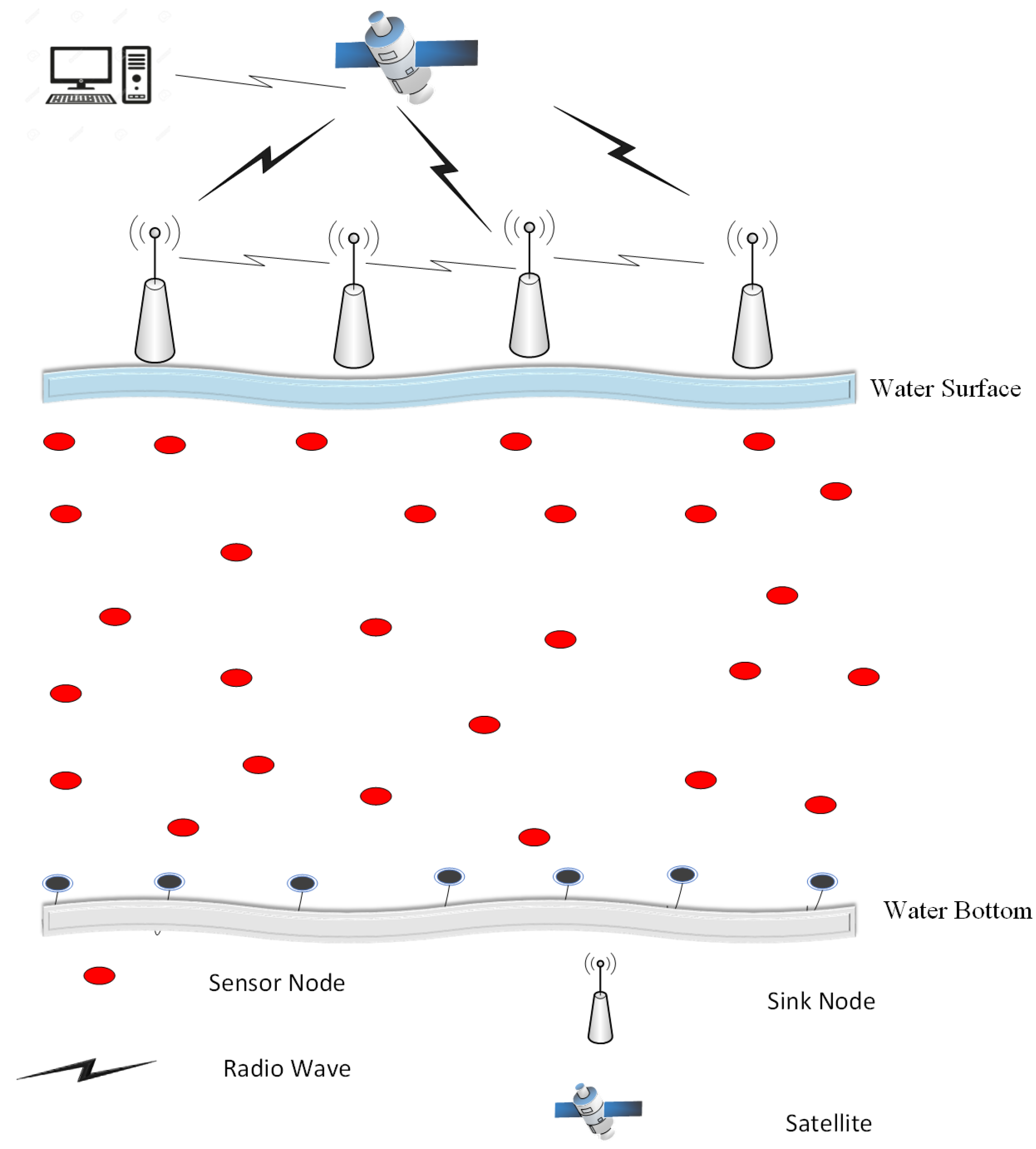
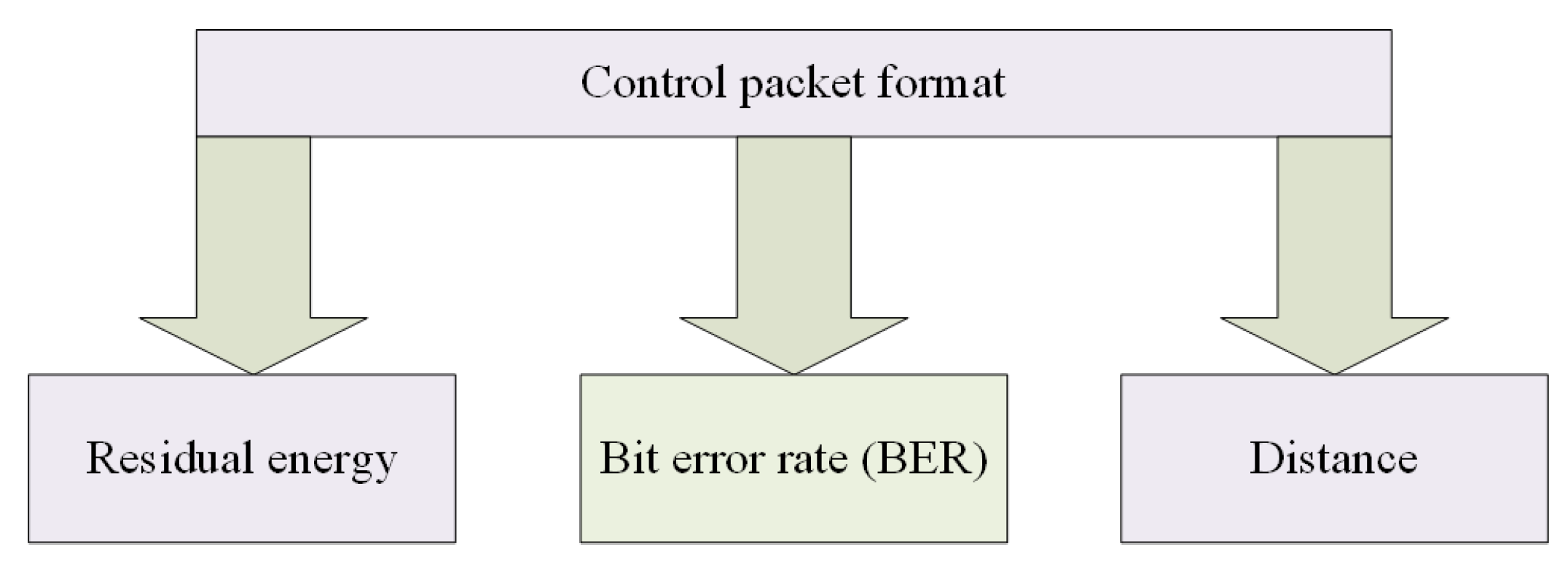
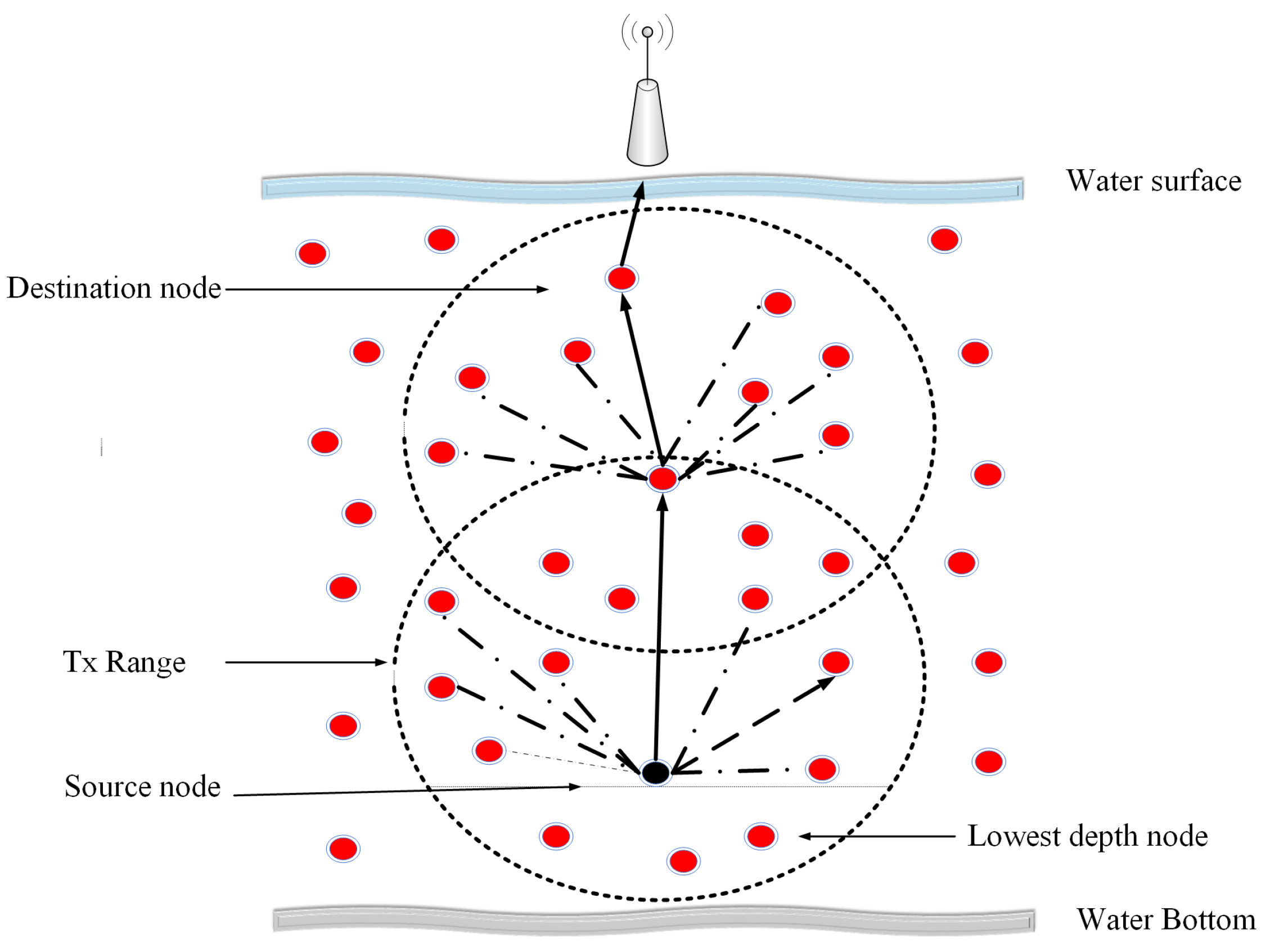

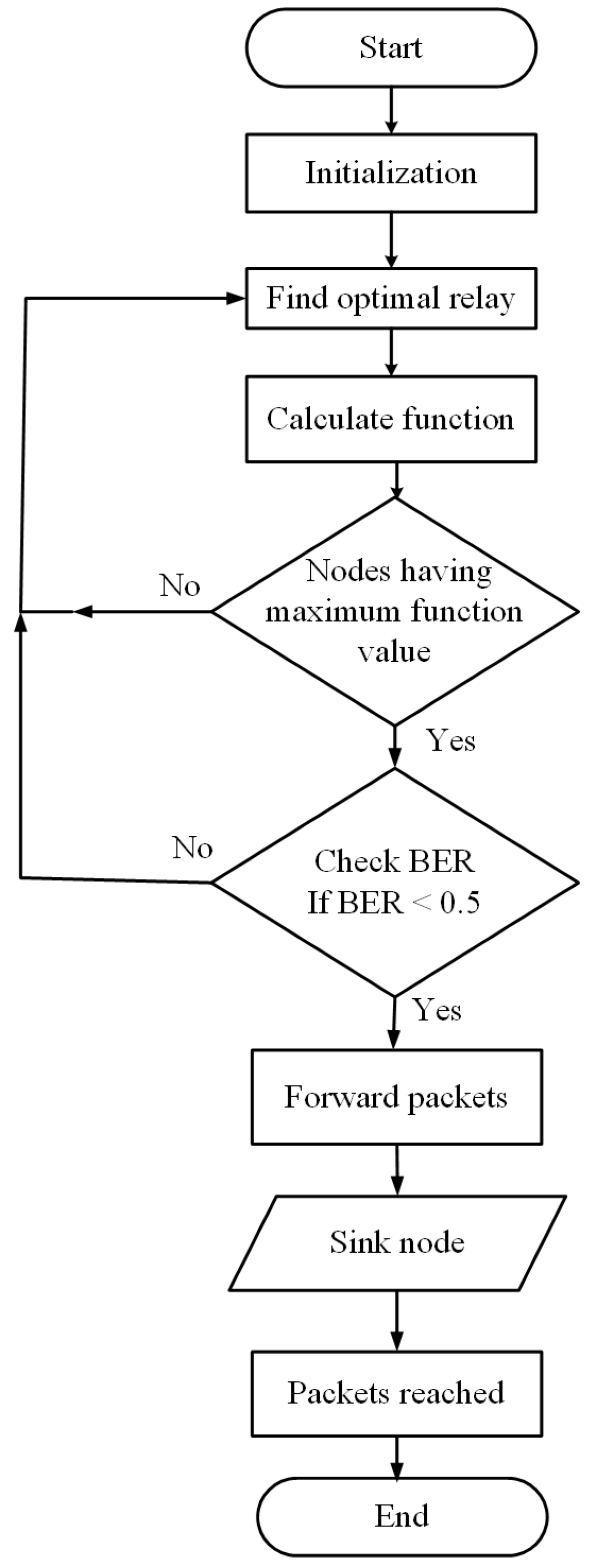
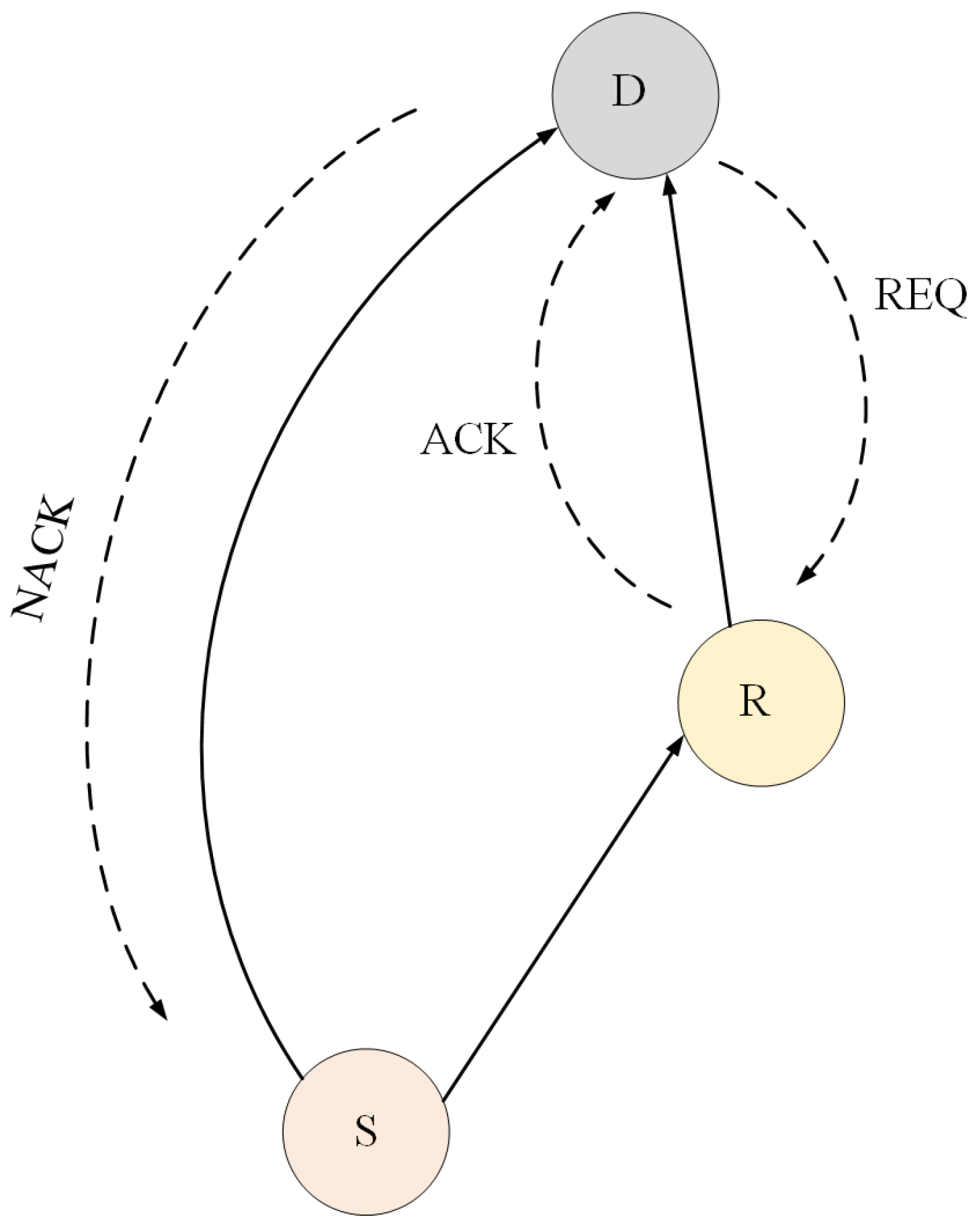
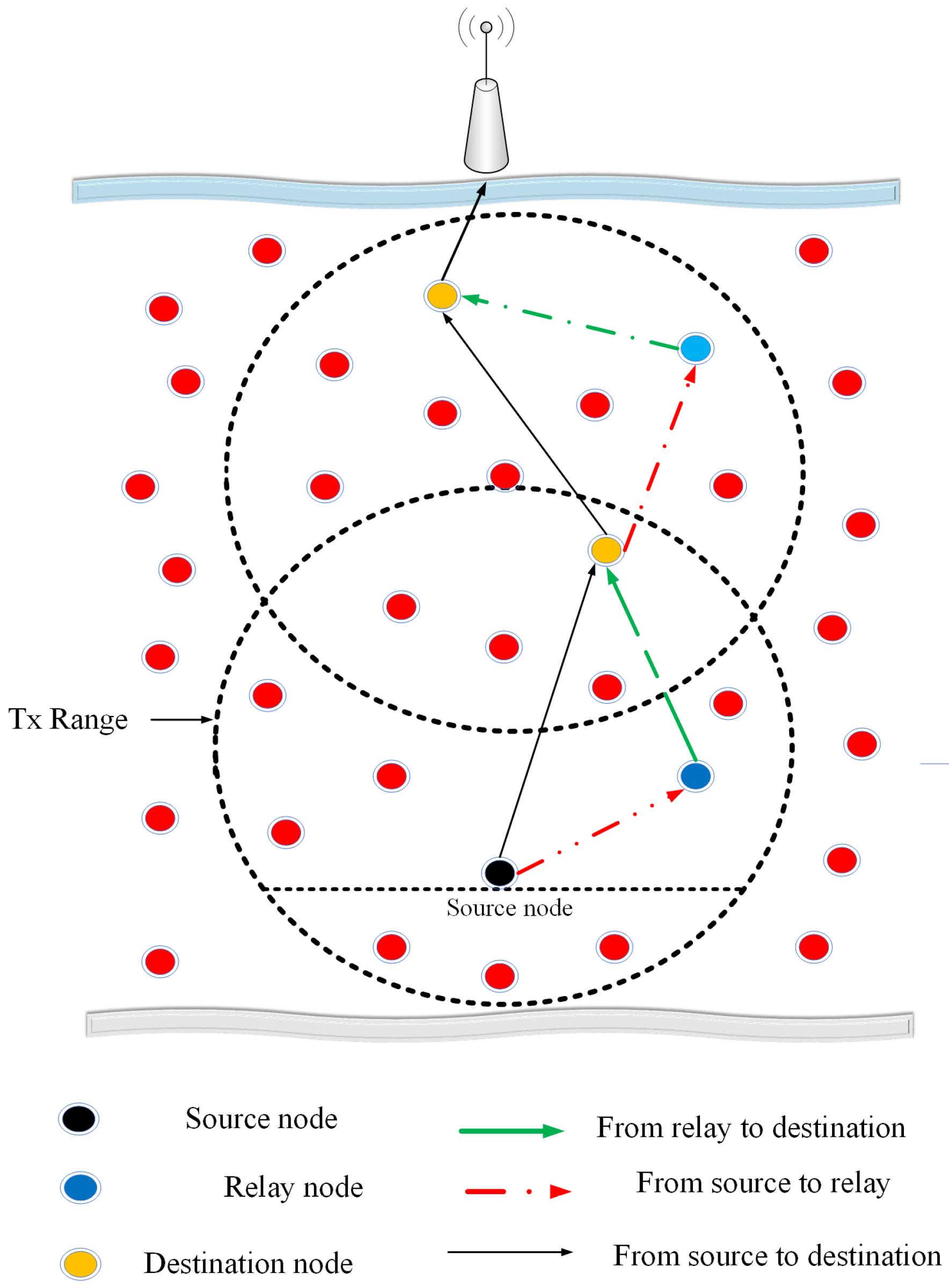
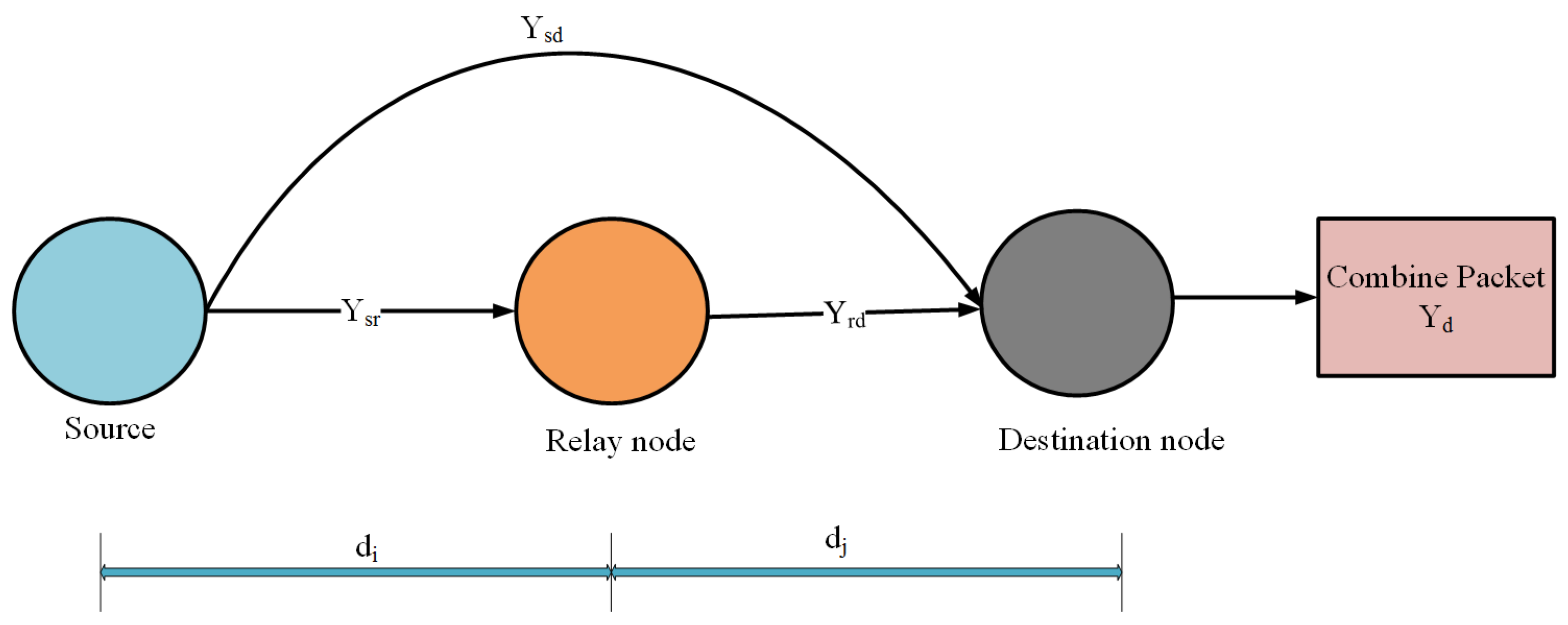

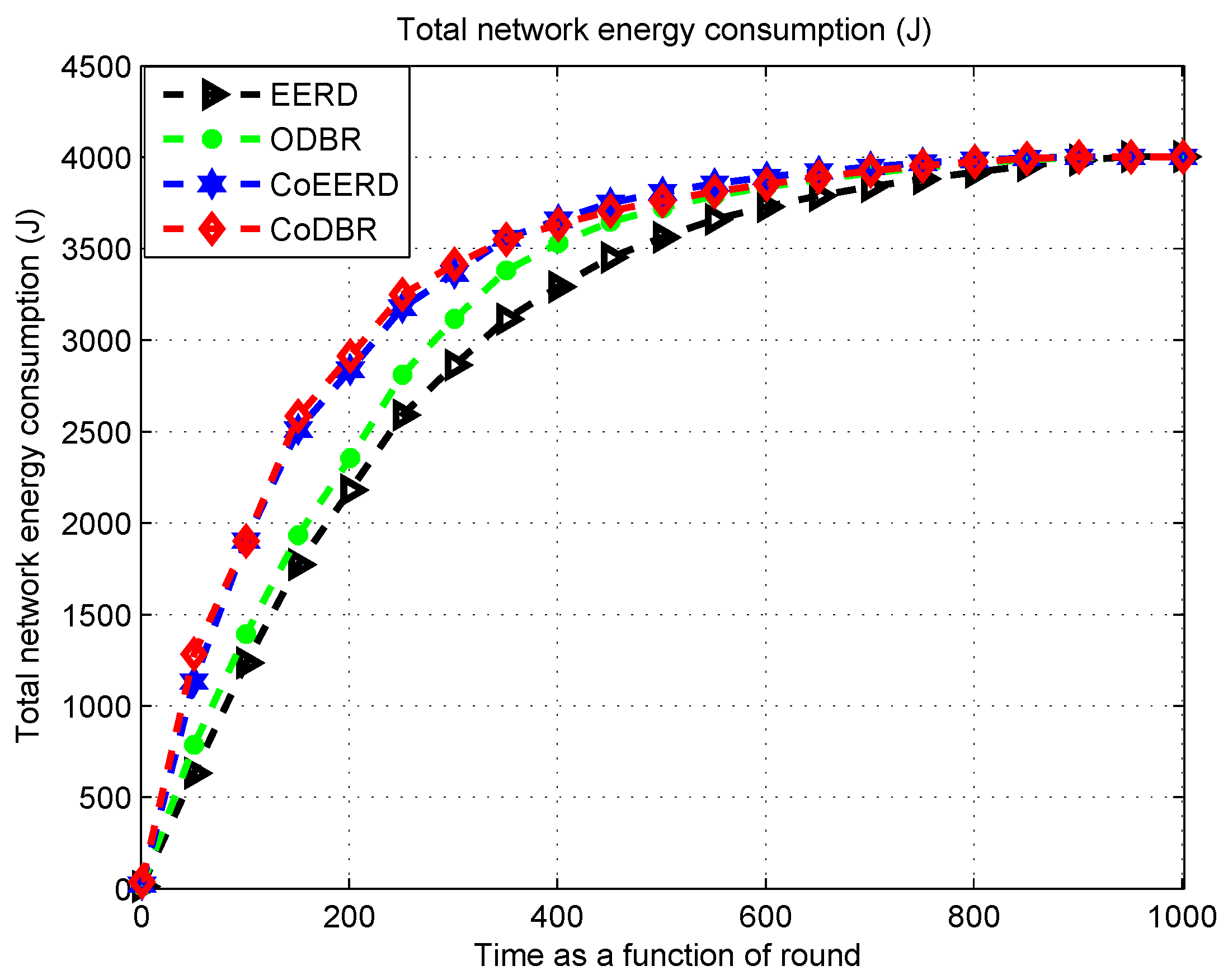
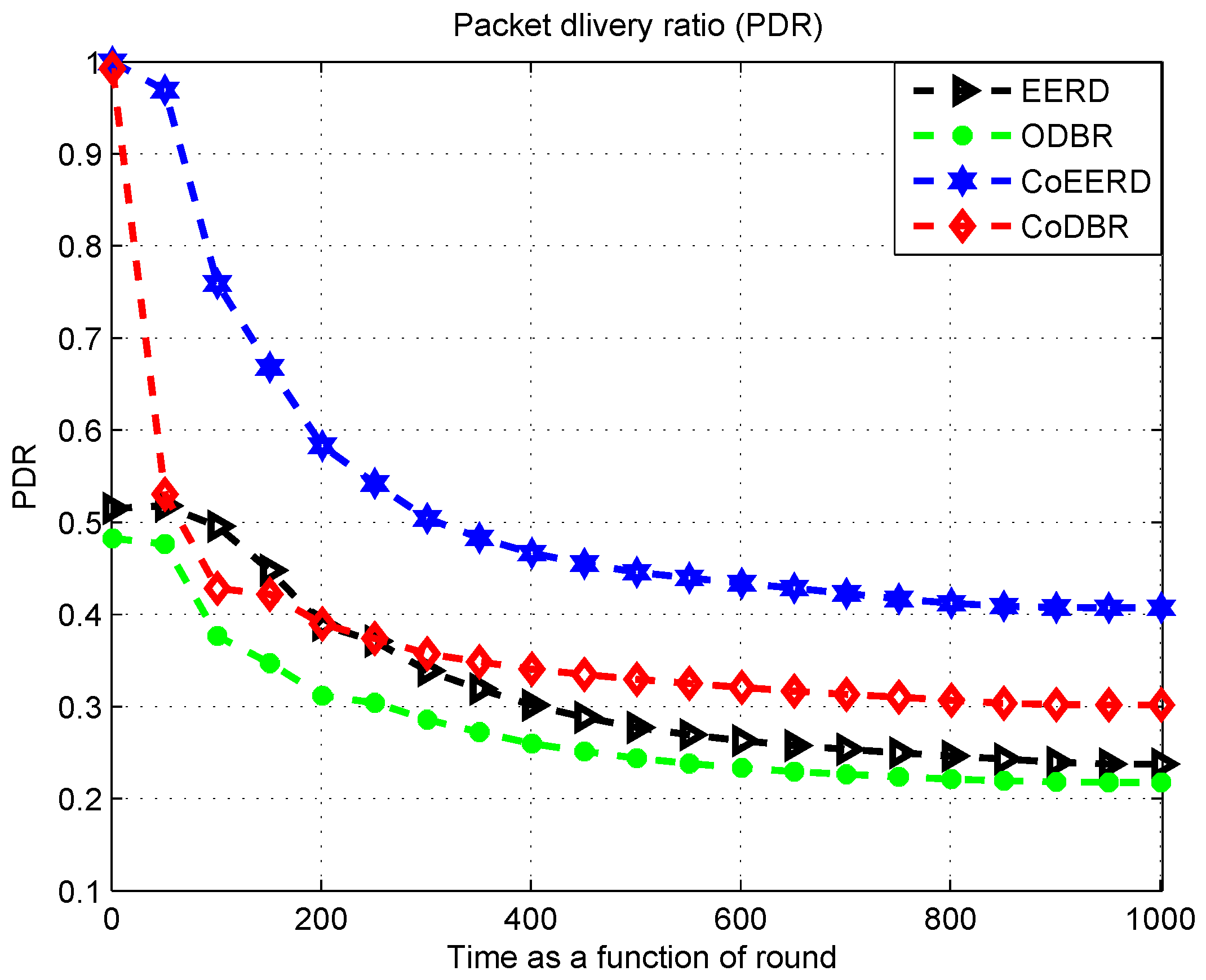
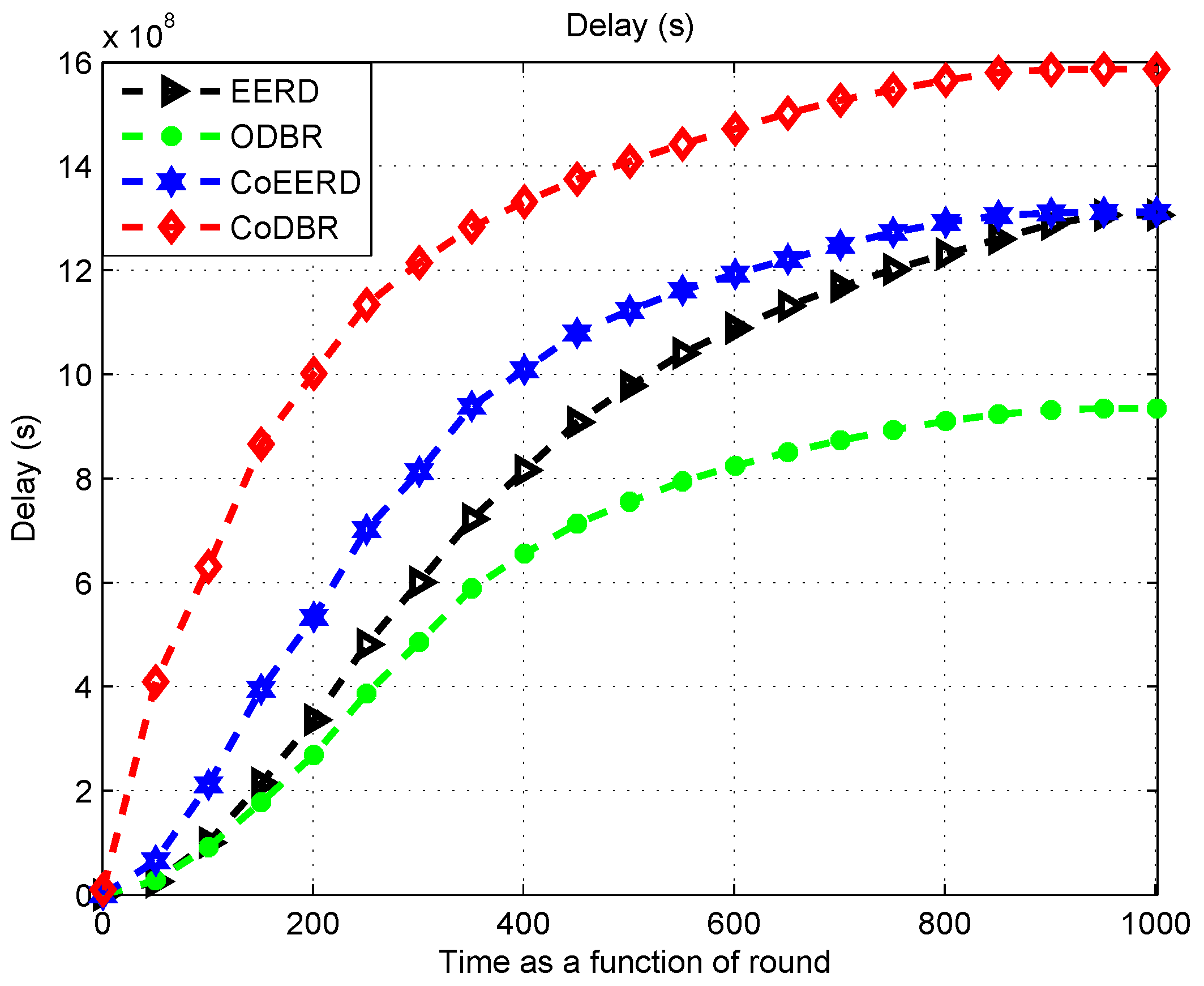
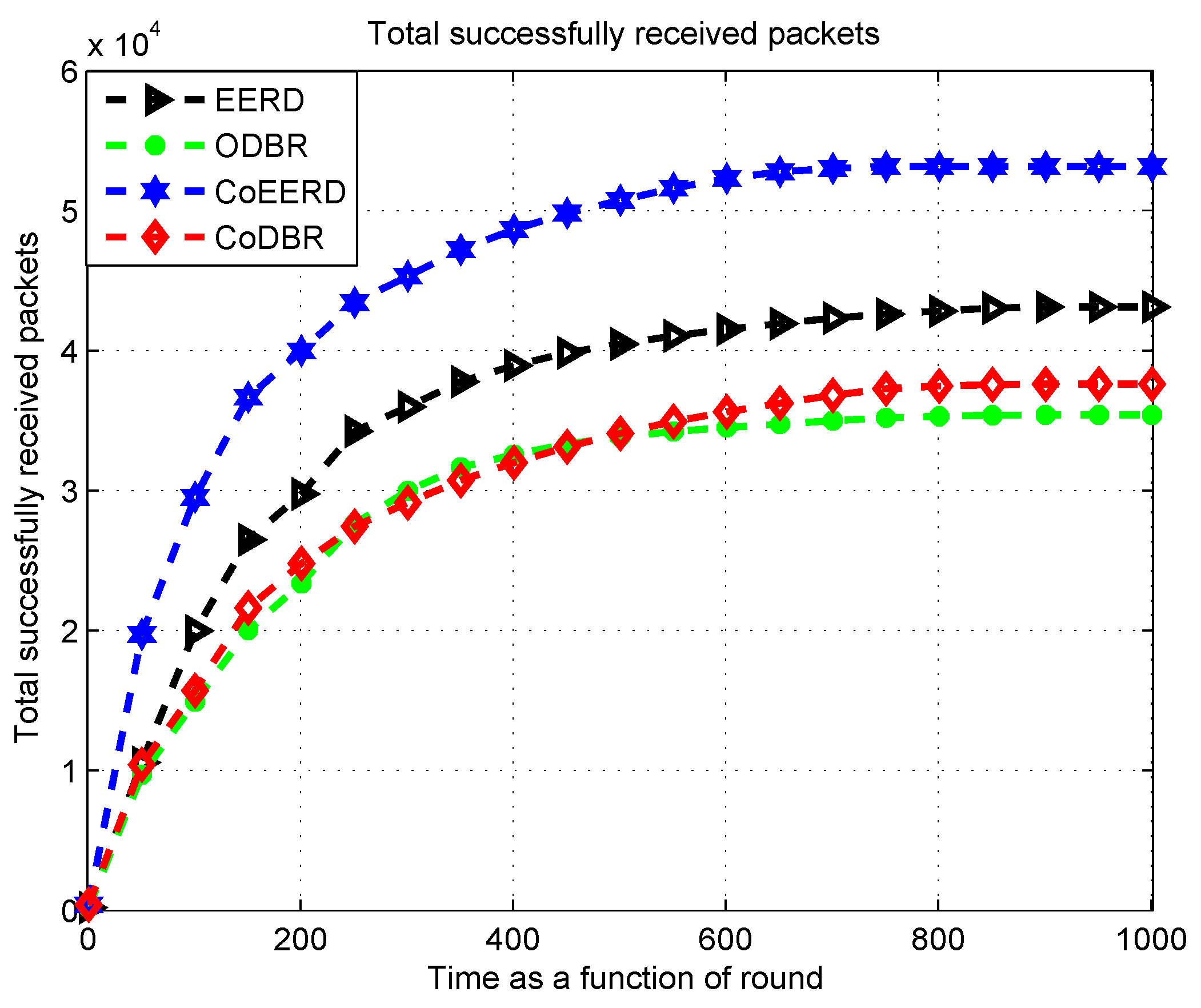
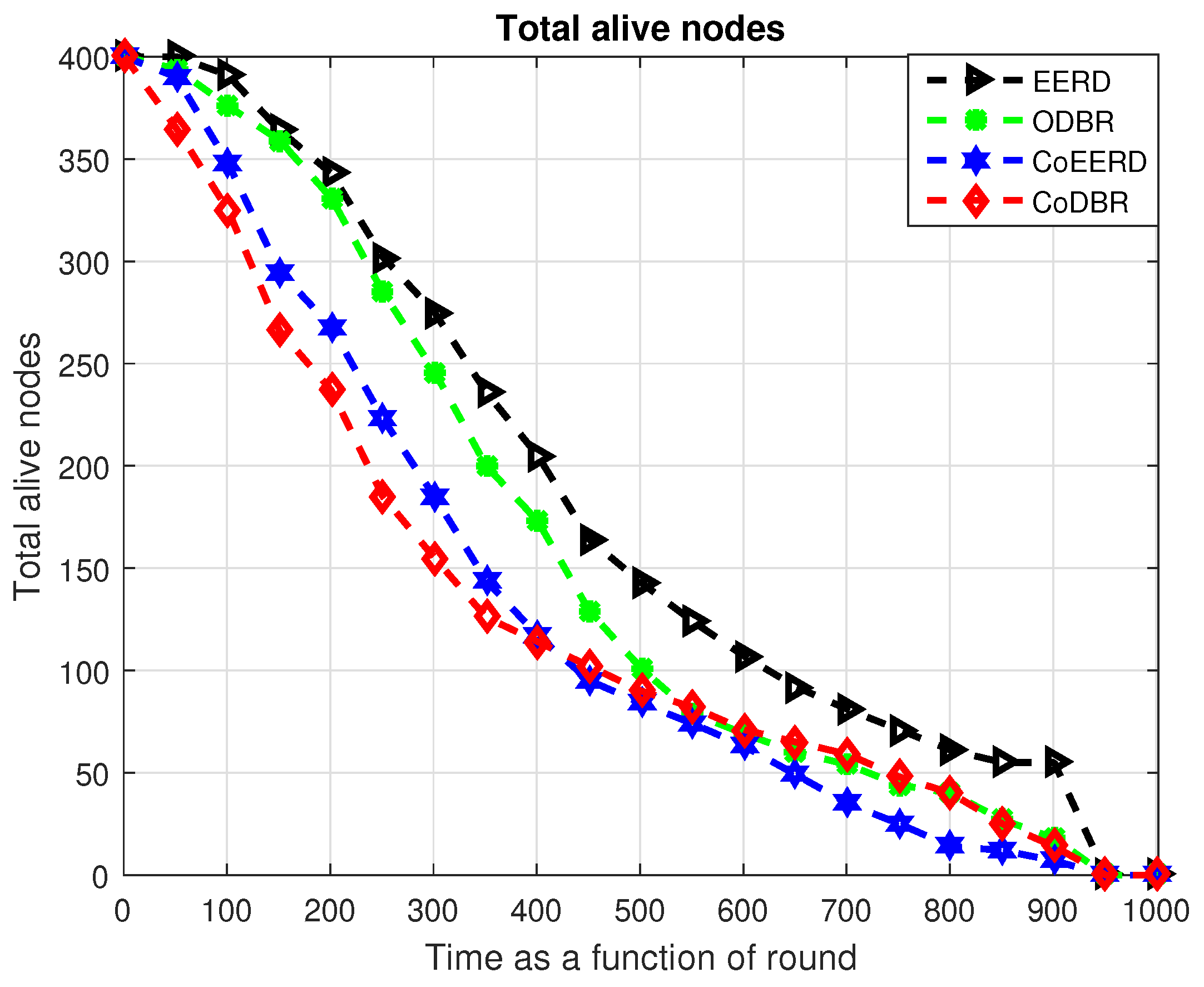
| Citations | Year | Technique Used | Advantages | Shortcoming |
|---|---|---|---|---|
| [15] | 2018 | Single-path routing scheme, data forwarder nodes are selected by considering the node position, residual energy, and fuzzy logic technique. | Minimizes the latency, consumes low energy. | Due to single-path routing loses the reliability. |
| [17] | 2018 | Cooperative base scheme, aggregators to forward the packets in random manner. | The work deals with delay and increase network throughput. | The use of aggregators makes the network complex. |
| [18] | 2017 | Region base non-cooperative algorithm, uses the sink mobility in vertical and horizontal directions, considers lowest depth, SNR, and highest residual energy for best relay selection. | Balances network energy consumption, retains maximum nodes alive. | Loses the reliability and drops maximum packets. |
| [19] | 2017 | Both the cooperative and non-cooperative schemes used the node position information by considering distance and mobile sinks for information advancement. | To overcome the void space problem in the network, decreases latency, and increases the throughput. | Consumes maximum energy due to the deficiency of the balanced energy technique. |
| [20] | 2016 | Cooperative base routing scheme, Used an energy harvesting technique on the source and relay node. | The scheme maximizes the network throughput and ensure reliability due to cooperation. | The network is complicated and increase the network delay. |
| [21] | 2016 | Cooperative single relay scheme, highest residual energy, lowest depth, and channel consideration is used for data forwarder nodes selection. | Improves the network reliability, forwards maximum information towards the sink node, reduces delay. | Consumes high energy, nodes die quickly, loss accuracy. |
| [22] | 2016 | Cooperative base routing schemes, uses the least number of neighbor and distance for best forwarder node selection, uses MRC technique for diversity. | Balance energy consumption, prolong the network, enhances the PDR. | Render high latency during the packet advancement, loss the data accuracy. |
| [23] | 2016 | Cooperative base scheme, single relay used with DN, Uses four mobile sink nodes, for diversity use MRC technique. | Due to sink mobility reduces the delay, balance energy consumption, retains maximum nodes alive. | it blindly selects the channel link for transmission data which affects the PDR. |
| [13] | 2016 | Non-cooperative base routing scheme, used a region base network. | Saves the network energy, maximizes the network life-span. | Reduces the network reliability drop maximum packets. |
| [24] | 2015 | Cooperative routing scheme, for best forwarder nodes selection considers the lowest distance and lowest SNR value. | Maximize the throughput, enhances the network reliability, ensure data accuracy. | Lowest depth node dies quickly, increase the latency, consumes maximum energy. |
| [14] | 2014 | Cooperative single relay scheme, best forwarder nodes are selected by considering the weight function, use MRC technique. | Ensures data accuracy, improves the link quality, reduces the channel affects. | Consumes high energy, nodes die quickly. |
| [25] | 2007 | Cooperative-based routing scheme, used cognitive multiple access instead of conventional relaying technique. | The scheme deal with the latency and maximize the network throughput. | Nodes in the network consume high energy. |
| Parameters | Values |
|---|---|
| Total sensors nodes | 400 |
| Total sink nodes | 4 |
| Deployment area width | 500 m |
| Deployment area depth | 500 m |
| Data packet size | 1000 bits |
| Wind speed | 10 m/s |
| Control packet size | 48 bits |
| Idle mode exhaust power | 10 mW |
| Transmission power | 2 W |
| Reception power | 0.5 W |
| Initial energy available for 1000 rounds | 10 J |
| Transmission range | 100 m |
| Bandwidth | 30,000 Hz |
© 2019 by the authors. Licensee MDPI, Basel, Switzerland. This article is an open access article distributed under the terms and conditions of the Creative Commons Attribution (CC BY) license (http://creativecommons.org/licenses/by/4.0/).
Share and Cite
Ullah, U.; Khan, A.; Zareei, M.; Ali, I.; Khattak, H.A.; Din, I.U. Energy-Effective Cooperative and Reliable Delivery Routing Protocols for Underwater Wireless Sensor Networks. Energies 2019, 12, 2630. https://doi.org/10.3390/en12132630
Ullah U, Khan A, Zareei M, Ali I, Khattak HA, Din IU. Energy-Effective Cooperative and Reliable Delivery Routing Protocols for Underwater Wireless Sensor Networks. Energies. 2019; 12(13):2630. https://doi.org/10.3390/en12132630
Chicago/Turabian StyleUllah, Ubaid, Anwar Khan, Mahdi Zareei, Ihsan Ali, Hasan Ali Khattak, and Ikram Ud Din. 2019. "Energy-Effective Cooperative and Reliable Delivery Routing Protocols for Underwater Wireless Sensor Networks" Energies 12, no. 13: 2630. https://doi.org/10.3390/en12132630
APA StyleUllah, U., Khan, A., Zareei, M., Ali, I., Khattak, H. A., & Din, I. U. (2019). Energy-Effective Cooperative and Reliable Delivery Routing Protocols for Underwater Wireless Sensor Networks. Energies, 12(13), 2630. https://doi.org/10.3390/en12132630







